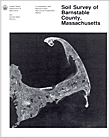The following is a map unit description from the "Soil Survey of Barnstable County, Massachusetts (Fletcher, 1993)"

HeA-Hinckley sandy loam, 0 to,3 percent slopes. This very deep, nearly level, excessively drained soil is in broad areas on outwash plains. It makes up about 0.2 percent (468 acres) of the survey area. It is mapped mainly in the Enfield-Merrimac-Carver general soil map unit. Areas are irregular in shape and range from 5 to 50 acres in size.
Typically, the surface is covered with an organic layer. This layer is about 2 inches of loose, undecomposed pine needles, leaves, and twigs and 1 inch of partly decomposed and well decomposed organic material. The surface layer is very friable sandy loam about 2 inches thick. The upper 1 inch is black, and the lower 1 inch is dark grayish brown. The subsoil is about 15 inches thick. The upper 1 inch is dark reddish brown, friable gravelly sandy loam; the next 7 inches is yellowish brown, friable gravelly sandy loam; and the lower 7 inches is yellowish brown, friable gravelly loamy coarse sand. The substratum extends to a depth of 65 inches or more. It is brownish yellow, loose very gravelly coarse sand in the upper 37 inches and light yellowish brown, loose gravelly coarse sand in the lower part.
Included with this soil in mapping are small areas of Carver, Enfield, Merrimac, and Plymouth soils. Also included are areas where slopes are more than 3 percent. Included soils make up about 25 percent of this unit.
Permeability is rapid in the subsoil of the Hinckley soil and very rapid in the substratum. Available water capacity is low. Depth to the seasonal high water table is more than 6 feet.
Most areas are used as woodland. Some areas have been developed for homesites, and a few areas are farmed.
This soil is poorly suited to cultivated crops because of the low available water capacity. Irrigation is needed for most cultivated crops. Mixing plant residue and manure into the surface layer increases the available water capacity, helps to maintain good tilth, and increases the organic matter content.
This soil is poorly suited to hay and pasture. The main management objective is the prevention of overgrazing, which reduces the hardiness and density of desirable plants. Proper stocking rates, timely grazing, and restricted use during wet periods help to maintain plant density and minimize surface compaction.
Because of the droughtiness, this soil is poorly suited to woodland. Thinning dense stands to standard stocking levels results in more vigorous tree growth. Di,seased, poorly formed, and otherwise undesirable trees should be removed when the stands are thinned. The most common trees are eastern pitch pine, white oak, scarlet oak, black oak, and eastern white pine. Generally, these trees are of poor quality.
This soil is suitable as a site for buildings with or without basements. The droughtiness is a limitation affecting lawns and shallow-rooted trees and shrubs. Adding a layer of topsoil and frequently watering during dry periods help to overcome this limitation. The soil readily absorbs but may not adequately filter the effluent in septic tank absorption fields. The poor filtering capacity may result in the pollution of ground water. The hazard of pollution increases with the density of housing. Precautionary measures may be necessary in some areas.